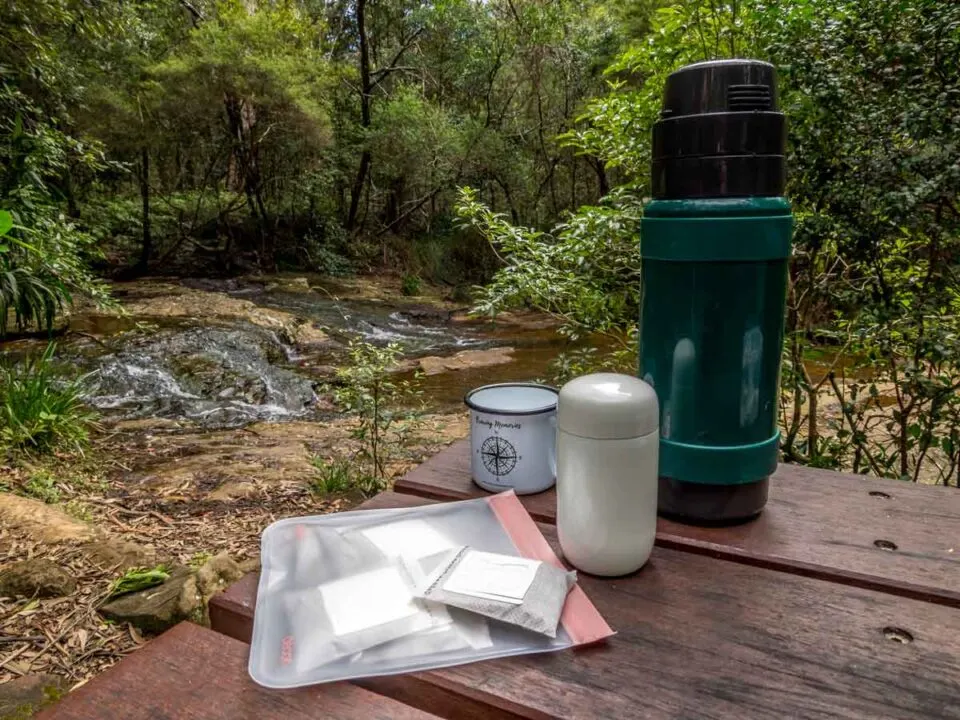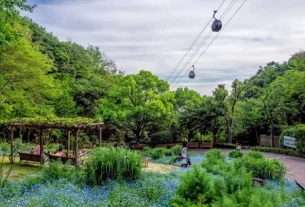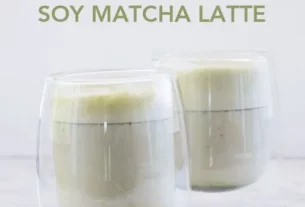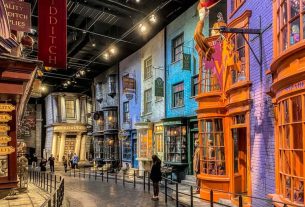We love our coffee. There is a definite deterioration in the mood if for some reason morning coffee fails to materialise, or it’s not up to par. With that in mind, we’ve taken certain precautions to ensure a good cuppa is never far away. There’s an inverter and tiny Nespresso in the motorhome, the Wacaco Nanopresso is a regular companion when travelling and then there is a recent rediscovery, drip coffee bags.

Now before anyone suggests I’m certifiable, I’m not talking about ‘coffee bags’, the teabag’s unfortunate cousin here. These are single-use, drip coffee brewing solutions that use a generous serve of premium freshly roasted and ground coffee. The drip construction including coffee grounds is fully compostable and your drink is made with the minimum fuss.
When I find solutions with the potential to make camping, RV life, hiking and general travel easier I have to give them a try.
Table of Contents
Hanging ear drip coffee
We first came across drip coffee bags in Japan many years ago. Translated from Japanese they are called ‘hanging ear drip coffee’ for those little cardboard ears used to hold them in place. They have been a thing in Japan since the 1990s with popularity growing across Asia since the design was patented back in 2001.
Hanging ear drip coffee is very mainstream in Japan, you’ll find boxes of them in supermarkets and convenience stores like 7-eleven. While commonly used in the home, and super convenient in hotel rooms, they come into their own outdoors. We were initially surprised how popular hiking and just being outdoors spending time in nature is in Japan, they even have a word for it, shinrin-yoku. After seeing how much of Japan is covered in stunning natural scenery and how little is actually big cities like Tokyo and Osaka it is a lot less surprising.

We’ve met hikers in Japan many times, sometimes travelling on trains out from the cities and at other times on the trails in National Parks and the mountains. I can see how a lightweight and space-saving solution like this would be useful in that situation and in equally in Australia where so many of us love to get out to the beach or rainforest and spend our free time hiking, fishing, camping and exploring.
Is a drip coffee bag just instant coffee?
No. It’s not.
Instant coffee is pre-brewed coffee that is then dehydrated, ground to a powder, sometimes re-formed into a crystal and then dissolved in water again to rehydrate it when it’s time to drink. The flavour of instant coffee is quite different to coffee prepared by any of the brewing methods.
The main coffee brewing methods
Brewing coffee involve the whole coffee bean that has been roasted and then ground. The grind varies by method and preparation but can vary from coarse chips to a very fine powder.
Pressure extraction
When coffee is made by your local barista, through a home pod or barista machine the extraction is done under pressure. It is a precision method and both the quality of the equipment and the skill of the user come into play to varying degrees depending on the machine.
Coffee made by pressure extraction is known for its richness and the quality of the crema but requires more equipment, setup, preparation and clean up than other methods.
Drip
The drip method wets the coffee grounds with hot water to bloom or activate them and then the hot water is very slowly poured over extracting flavour. Because the coffee and water stay in contact for a shorter time it is typically not as strong.
Drip coffee can be made with a drip coffee machine or using single-use drip coffee bags.

Immersion
An example of the immersion brewing method is the french press, also called the coffee plunger. Using this method hot water is poured on top of the coffee grounds which are then held submerged in the water until the desired flavour is reached.
It typically creates a strong brew because the grounds and water are left in contact for a longer time. It is also favoured by many because it is simple to set up and prepare.
This method is also frequently used for cold brew, using water that is either cold or at room temperature. An extended time is allowed for extraction with the objective of achieving a slow brew that has a mild mellow flavour with less acidity and allows the other flavour notes to become more prominent.
Drip coffee bags in Australia
For the past few months, we’ve been putting the Grounded Drops drip coffee bags through their paces. our intention has been to use them while out and about, while hiking, on road trips and on picnics. While we do like to buy a coffee and support local businesses, equally we spend a lot of time off the beaten path where there’s not a barista around every corner.

For us, the pantry packs have been the best balance between freshness, convenience and minimising the packaging from both a storage and waste perspective. The large pantry pack contains 36 individual preloaded drip filters, smaller packs containing 12 or 24 are also available. I transfer enough for the day, or a few days on a short trip into a small airtight container and that works for us but individually foiled packets are also available depending on your needs.
Take a look at the Grounded Drops range
Purchases through this link will have the 2AussieTravellers 15% discount code automatically applied
I liked the idea that this way I am using my own reusable cup and that the filter bag, coffee and cardboard handles can all go directly into the compost or worm farm when available.
For me it came down to two key questions. First, does the drip design work to brew a coffee that extracts sufficient strength, flavour and complexity from the grounds and second, is the quality of the bean, roast and grind optimal for making a coffee using this brewing technique.
When it comes to flavour it’s a personal thing but for our 2 cents, we found the strength good from a single bag even with our preference for a longer drink and often but not always adding milk. We experienced no bitterness or excess acidity in the brewed coffee which will be at least partly due to them being air roasted which removes the chaff.
I’m a coffee lover, not a connoisseur so won’t try to describe fruit flavours or other aromas beyond what is printed on the pack. The two single-origin blends (Colombian and Kenyan) recommend serving either black or with milk. The Hodophile blend, I guess that means it’s made for us road trippers, recommends serving with milk and is a blend of beans from Africa and South America. When it comes to drinking coffee I have no issue following rules so tried the 5 variations as recommended and beyond my own slight preferences, I enjoyed them all.
We tried all 3 blends and the flavour profiles were distinct, I enjoyed them all with a slight preference for the Wayfarer, the Colombian blend. That said I would probably still mix it up in future orders.
How to use drip coffee bags
Making the drip coffee is a simple process. You take the filter bag and tear it gently along the marked line to open it. Pull the ears, or handles, on either side and loop those over the rim of your cup or mug.
To heat the water use whatever method works best for you. A mini camping stove is light and compact to carry if you are going off the grid for a while but in Australia, the bush fire risk is high throughout most of the year so we usually take an unbreakable stainless thermos. The best temperature to make coffee is around 93 Celcius, a little bit off boiling point anyway so we find this works well.

Pour water into the drip filter until the coffee is fully wet and allow it 30 seconds or so to bubble up and bloom, this is just to allow the CO2 to escape so the remaining water can more fully capture the flavour from the coffee grounds. Continue pouring slowly, stopping briefly as the grounds are covered to allow it to drip through until the desired level and flavour is achieved. Add milk or anything else you want and enjoy. It really is quite a therapeutic process.
In Australia, we have excellent dairy products so I use fresh milk not creamer in my coffee, even if it is perhaps slightly less convenient. I’m happy to drink it black but I do enjoy the slightly thicker richer feel of a white coffee.
I picked up a small 250 ml stainless steel thermos with a wide enough top that it’s easy to clean thoroughly and use to carry a few splashes of milk. It keeps it safely cold for the day even in a Queensland summer.

Final thoughts on the Grounded Drops drip filter bags
As a convenient, lightweight solution to brewed coffee with minimum gear, these worked well. It’s quick to make, not much can go wrong and the resulting drink was good every time. For flavour, strength and a smooth drink, I’d rate them well.
The origin of the beans is clearly displayed at purchase and on the bags, my understanding is that the coffee is locally roasted in NSW and the foil zip-locked pantry bags kept the flavour fresh. I also liked the low waste aspect of the construction while noting that the foil bags while necessary to maintain optimal freshness aren’t recyclable.
Will I continue using them? Yes, I will. I’m not going to stop frequenting my favourite baristas or be throwing out my coffee machines any time soon but the drip bags definitely have their place in my coffee routine.
Order your own Grounded Drops caffeine fix
Purchases through this link will have the 2AussieTravellers 15% discount code automatically applied
If you found this article useful please consider saving it to Pinterest. It makes it easy for you to find it again, it helps us, and it helps other travellers to find the information they are looking for.



